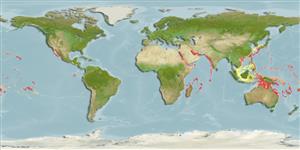Common names from other countries
Teleostei (teleosts) >
Anguilliformes (Eels and morays) >
Ophichthidae (Snake eels) > Myrophinae
Etymology: Scolecenchelys: Greek, skolex = worm (1855) + Greek, enchlys, -yos = eel (Ref. 45335).
Environment: milieu / climate zone / depth range / distribution range
Ecology
Marine; reef-associated; depth range 0 - 60 m (Ref. 104540). Tropical
Indo-Pacific: widespread, from South Africa to Fiji, north to central Honshu Island, Japan, including Australia and the Red Sea.
Size / Weight / Age
Maturity: Lm ? range ? - ? cm
Max length : 20.0 cm TL male/unsexed; (Ref. 104540)
Short description
Identification keys | Morphology | Morphometrics
Vertebrae: 122 - 129. This species of the Scolecenchelys gymnota species group is distinguished by the following set of characters: head 8.4-10 % TL; tail 51-54 % TL; trunk 34-38 % TL; infraorbital pores 2 at the postorbital area; absence of median ventral groove on the snout; acute snout; rictus of mouth is slightly posterior to a vertical through the posterior margin of the eye; uniserial teeth on jaws and vomer; horizontal distance between dorsal-fin origin and a vertical through mid-anus 3.4-57 % HL; predorsal vertebrae 54-59, preanal 53-56, total vertebrae 122-129; MVF 57-55-126 (Ref. 104540).
A shallow water species occurring from rock tide pools or coral reefs to 60 m depth (Ref. 104540).
Life cycle and mating behavior
Maturities | Reproduction | Spawnings | Egg(s) | Fecundities | Larvae
Hibino, Y. and S. Kimura, 2015. Revision of the Scolecenchelys gymnota species group with descriptions of two new species (Anguilliformes: Ophichthidae: Myrophinae). Ichthyol Res (Ref. 104540)
IUCN Red List Status (Ref. 130435)
CITES (Ref. 128078)
Not Evaluated
Threat to humans
Harmless
Human uses
Tools
Special reports
Download XML
Internet sources
Estimates based on models
Preferred temperature (Ref.
115969): 23.7 - 28.2, mean 26.9 (based on 454 cells).
Phylogenetic diversity index (Ref.
82804): PD
50 = 0.5000 [Uniqueness, from 0.5 = low to 2.0 = high].
Bayesian length-weight: a=0.00076 (0.00029 - 0.00199), b=3.06 (2.83 - 3.29), in cm Total Length, based on LWR estimates for this (Sub)family-body shape (Ref.
93245).
Trophic level (Ref.
69278): 3.9 ±0.7 se; based on size and trophs of closest relatives
Resilience (Ref.
120179): High, minimum population doubling time less than 15 months (Preliminary K or Fecundity.).
Fishing Vulnerability (Ref.
59153): Low vulnerability (10 of 100).
